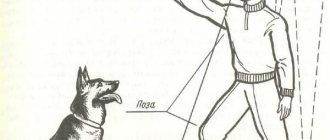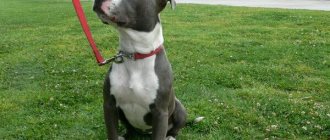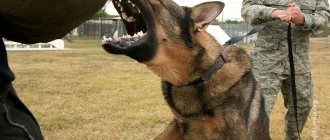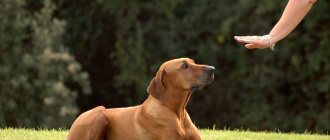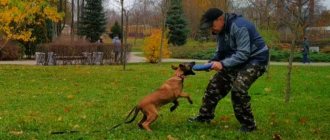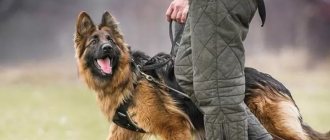The history of the Shar Pei breed dates back to ancient times, which is why it is impossible to accurately trace the moment of its origin.
In appearance, this is a dog with a strong build and milk-like appearance.
Since ancient times, animals have had excellent physical characteristics, so it is not surprising that at one time the breed was used as a fighting dog.
However, over time, Shar-Peis began to be noticed as not conforming to the type of a typical fighter.
The dogs were distinguished by their calm and balanced character, so soon the breed again appeared before the audience, but in the role of a hunter and watchman.
Are they easy to train?
The breed standard classifies Shar-Peis as guard and hunting dogs, so the animal is just right to have certain instincts.
However, many owners come to the conclusion that, despite their potential, Shar Peis are difficult to train .
The problem lies in the stubbornness of the breed. The dog is distinguished by intelligence, intelligence and self-esteem, so it is not surprising that the pet can only raise its head with interest in response to the owner’s attempts.
The relationship between the animal and the owner should be built on a partnership basis . If the owner of a Shar Pei can correctly present himself and the pet’s position in the hierarchy, then it is only a matter of time before the dog becomes involved in the life of the family.
Delicacy
Shar Pei training, like any other dog, is based on treats. Definitely in puppyhood. What is a treat?
- Finely chopped chicken gizzards (boiled).
- Finely chopped beef heart, also boiled.
- Beef kidneys, boiled and finely chopped.
- Tripe dried in the oven. Finely cut and stored in a cool place.
- White bread crackers.
Can it perform security functions and protect the owner?
Shar Peis are distinguished by their intelligence and boundless devotion, so it is not surprising that in critical situations they are ready to defend their family and home.
Especially if during training the dog was well trained in defense. Special attention should be paid to the external appearance of the animal and what advantages it provides.
The dog's skin is rich in folds, which is not only unpleasant to bite, but also makes it difficult to get to vital organs.
And low sensitivity allows you to avoid serious injuries if the offender, for example, grabbed the dog by the scruff of the neck. But if we talk about hearing and smell, then the situation is exactly the opposite.
Shar Pei perfectly hear and feel what is happening in the distance and can assess the scale of a potential threat in order to subsequently take appropriate measures..
Therefore, there is no doubt about the security and protective functions of the animal.
Origin of the breed
There are several versions of the origin of the Shar Pei. One of them says that representatives of this breed are descendants of one of the 4 primitive dogs of antiquity.
The second indicates that chow chows and ancient mastiffs can be found in the Shar Pei’s pedigree. True, very distantly related.
And the third hypothesis says that Shar Peis were bred in China. The work of the breeders was supervised by Emperor Qin Shi Huang. The task was to breed an animal with excellent guard qualities that could participate in battles. After the first representatives of the breed saw the light, the emperor himself personally burned all the papers indicating its origin. For what purpose this was done is unknown.
At what age should you start?
It is recommended to start training from the moment the puppy first crosses the threshold of a new home. And the first thing you need to start with is to accustom your pet to its nickname.
If it is advised to wait with training until the baby reaches full strength (3-4 months of life), then you should not delay education..
Moreover, in relation to Shar-Peis, it is advised to consolidate skills throughout their lives, otherwise they may forget what is possible and what is not. And Shar-Peis are difficult to re-educate.
It is recommended to train the pet in whatever way the owner deems necessary . But regardless of whether he is taught or not, he still learns something himself. And so that the pet does not get lost, it is recommended to start training the dog as early as possible.
Where to start education
As a rule, a new home for a dog is unexplored territory from which you don’t know what to expect . Therefore, it’s time for the owner to teach the puppy a couple of lessons taught here.
The rules must clearly set the boundaries of what is permitted, regardless of the situation and other factors. If it was said “impossible”, it means “impossible”.
List of basic rules:
- limit freedom of action: whether in relation to visiting rooms or the right to use household utensils;
- furniture – taboo: do not chew, do not slobber, do not climb;
- to throw out excess energy exclusively without harm to anyone or anything;
- hunting instincts should be used exclusively in sport, and not in relation to other household members or domestic animals.
Do not forget that Shar Peis are representatives of oriental breeds, and they have a lower pain threshold than their counterparts.
Dogs are not good at perceiving physical pressure and they steadfastly endure a number of repressions due to their physique.
Therefore, in relation to the Shar Pei, total control and attempts to achieve results through force are not encouraged. You should establish a trusting relationship with the dog and explain step by step what you want from it.
Training an adult Shar Pei
Once you have gone through a basic level of dog training with your Shar Pei, you will likely notice the level of intelligence that this dog carries. Start by introducing your Shar Pei to agility sports - this is a great way to keep you both mentally and physically stimulated . Additionally, it is highly recommended to look for games to stimulate your dog's sensory and cognitive abilities.
If you think you don't have enough time or knowledge to deepen your Shar Pei's education, we recommend contacting a dog training center. These centers offer guidance from a professional in the field of continuing education.
How to toilet train
At first, you need to decide on a place for the toilet and do not forget to educate the pet himself about this. The dog must clearly know where to relieve itself.
If the owner is the owner of a private house, then such a place should not be located at a distant distance from him, on the contrary.
A puppy under 3 months of age should be taken outside after feeding and active play. Similar to those situations when a puppy begins to look around suspiciously or spin around in one place, trying to settle down somewhere.
Young puppies are not very patient, so it is a matter of time before the pet deigns to relieve itself . It is in the interests of the owner if this happens outside the apartment or house.
It is strongly recommended not to disturb the dog or rush it. Be patient, your pet should have the opportunity to sniff everything thoroughly. At the end of the action, praise and a couple of kind words will not be amiss.
This will let the dog know that he did everything right..
Training and training a young dog
Even before a charming, plump puppy appears in the house, a person should worry about choosing a dog handler-instructor. For a young puppy, group classes in UGS (controllable city dog) or OKD (basics of canine training) are ideal. As a rule, such groups involve 7-10 dogs of a similar age, so the puppy can not only learn how to follow commands, but also gain socialization and experience interacting with their relatives.
Group training teaches the dog not to be distracted by stimuli
Since the Shar Pei is not a service breed, it will be enough to study the basics of obedience with the dog. This is necessary in order to feel comfortable with your pet not only at home or in a deserted park, but also in places where there are a lot of people, vehicles or other animals. The Shar Pei's high intelligence allows him to achieve good controllability; the main thing is to exercise regularly and systematically, that is, move from one learned command to another.
Basic commands for Shar Pei
In fact, a small set of commands is enough, which a Shar Pei dog must carry out unquestioningly and on demand. These include:
- “Nearby” - the movement of the dog at the owner’s left knee on a slack leash, without tension.
- Complex “Sit – Lie – Stand” - execution of commands both individually and in different combinations.
- “Place” - keeping the dog in a place specified by the owner (indicated by some object, usually a leash or bag).
- “Come to me” is the most important command, according to which the dog must come to the owner and sit at the left knee.
- “No” or “Fu” - prohibition of an unwanted action, for example, picking up from the ground or loud barking.
Restraint commands are especially effective when trained among several dogs.
How to teach basic commands
Sit
Undoubtedly, a dog can sit without a command, but the owner’s task is to ensure that the dog not only understands what this action is called, but also performs it according to order.
The training of the command begins with a treat, which the owner takes in his hands and holds just above the dog’s eye level..
Next, the command itself is pronounced, and the treat, meanwhile, slowly rises up and freezes in place, prompting the animal to sit on its paws and lift its head so as not to lose sight of the food.
If the dog tries to jump up or jump, hold it back with gentle pressure on the lower back . Remember that during lessons the hand with the treat should not be too high, otherwise the excited Shar Pei will immediately jump towards the tasty morsel.
Expert opinion
Kozhevin Semyon Kirillovich
Expert dog handler.
The command is practiced until the animal understands the principle of operation.
In the future, it will be possible not to resort to food encouragement, but to limit yourself to kind words.
Lie
Let's consider one of the options for teaching the “lie down” command. The owner’s actions are structured as follows: a person gently places his hand on the animal’s withers, while the other one is smoothly placed behind the front paws.
The decree sounds and the first hand puts pressure on the withers, and the second at this time strives to stretch the animal’s paws forward . The dog has no choice but to lie on his belly, when words of encouragement are heard above his ear, and a treat may even flash in front of his nose.
You should pay attention to ensure that the animal lies straight and does not fall over, for example, on its back or side.
To correctly perceive the command, a few training sessions are enough so that the dog stops waiting for physical impact.
Ugh
At first, the pet must understand that the “fu” command means a ban and nothing more..
The command should sound strict and uncompromising, but at the same time calm and without aggression. Under no circumstances should you resort to shouting; instead, use a leash to hold the dog.
Before starting to train this command, the owner should understand that the “fu” command only implies a prohibition, not a brake..
Voice
A treat is taken into your hands and presented to the pet so that it can sniff it . After this, the hand with the food rises up and a command sounds.
An excited dog may attempt to jump after a treat, so the owner should first fasten a leash to the dog and deprive him of unnecessary actions (for example, stepping on him or tying him to some object).
In such a situation, dogs often sound full of indignation, and thereby fall for the bait . After the barking, the owner praises the pet and gives it a well-deserved treat. On average, a few repetitions are enough to practice a command.
Shar Pei behavior
While there is a tendency to talk about general traits when defining a breed's personality or behavior, the truth is that every dog has a unique personality. During training and training, each dog will take a different amount of time to learn. Therefore, when training a dog , it is important to remain devoted and patient with your puppy.
An important first step in knowing how to train your dog is knowing your dog . Watch your dog's behavior, posture and facial expressions. By better understanding your dog's body language, it will help you train and train the animal positively, while allowing you to strengthen the bond between dog and caregiver.
In general, Shar Pace are calm and balanced dogs, more independent than most breeds. This does not mean that you do not need love and attention, but simply emphasize that sometimes this breed requires moments of solitude and calm...
These furry pups are incredibly loyal and brave, especially if they feel the need to protect their guardians from threats. Therefore, they may be a little mistrustful of strangers and other animals. However, if you have received proper socialization, your Shar Pei should have no problem interacting positively with other animals, people, and the environment...
It also cannot be assumed that all Shar Peis have the same genetic inheritance, especially when it comes to behavior. As with all animals, their education, life experiences, training, care and environment will all play a role in determining a dog's...With Character.
Therefore, if you want your Shar Pei to be obedient, calm and friendly, you should not neglect your training or socialization. It will also be vital to offer your sha pei adequate preventive healthcare and a positive and safe environment in which they can freely develop their physical, cognitive, social and emotional skills...
Training scheme
| Age | Training |
| 1-3 months | During this period, the puppy explores the world around him and makes his first attempts at socialization in society. The puppy absorbs the behavior pattern of other household members and begins to become like them. Therefore, it is no wonder that the puppy should be surrounded by those who in the future will play one or another role in his life. This is a great age to gain the trust of a puppy and become a mentor for him. Remember that it is easier to teach a dog to come when called before it runs away from you. |
| 4-5 months | The puppy becomes aware of the scale of the world around him, and after this - an attempt to study the boundaries of what is permitted. At this time, it is advised to limit yourself to walks in familiar territories and only on a leash, in order to reduce the ardor of the novice explorer. In the worst case, the dog will make it a habit to ignore the owner’s orders and begin to test his patience. To avoid this, classes are used to train endurance and teach a couple of basic commands (for example, “sit”, “fu” and “come”). |
| 6-8 months | This age is a reflection of shortcomings in raising and training a pet. Moreover, puberty begins, and therefore a real rebel appears before the owner. But on the other hand, this is another reason to “consolidate” the lessons learned over the years. |
Basic mistakes
List of main errors:
- Subjectivization of a dog's behavior, an attempt to see a person in it. This results in the owner beginning to make demands on the dog that it is unable to fulfill.
- Lack of consistency in training matters. Often the skill is practiced carelessly and is not fully consolidated.
- An attempt to retrain the animal, to instill a new model of behavior. This not only exhausts the dog’s nervous system, but also negatively affects the very result of the work done.
- Incorrect combination and use of stimuli. There is confusion between conditioned and unconditioned reflexes.
- Incorrect voice intonation when giving a command. Owners often abuse intonation, causing the dog to completely stop responding to the difference in voice.
- Treat abuse. It should be remembered that a treat is by no means the only measure of encouragement.
- There is no individual approach. Ignoring the individual behavioral characteristics of the dog being trained without trying to achieve the best result.
Almost every breed was bred for a specific purpose and for centuries could adhere to a certain lifestyle.
Therefore, before starting training at home, it is advised to familiarize yourself with the occupation of your pet’s ancestors, who left an individual imprint on the dog as a whole.
This will allow you to study the potential of the breed and, if possible, adapt it to your lifestyle.


